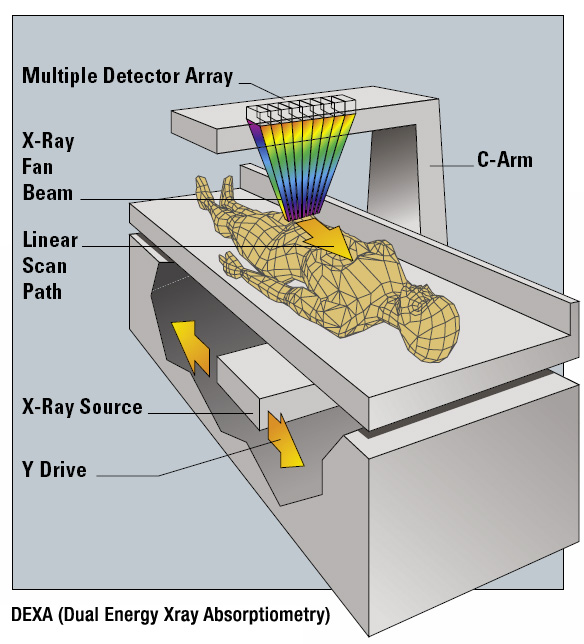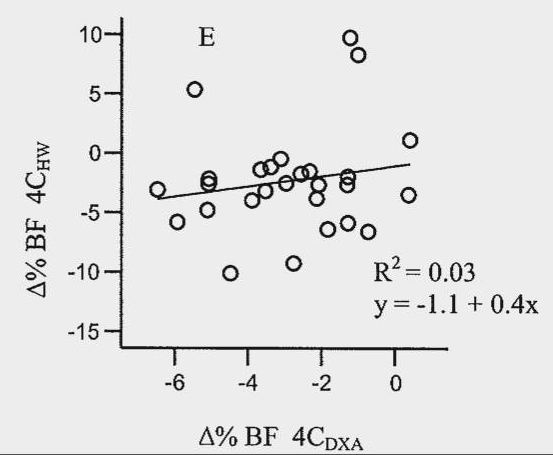In the first five parts of this series, I discussed various 2-compartment models of estimating body composition. These models divide the body into fat and fat-free mass. Now let's talk about a common 3-compartment model: dual-energy x-ray absorptiometry (DEXA).
DEXA
DEXA, once used for determining bone density, evolved into a technique for also estimating body composition. DEXA represents a 3-compartment model for estimating body composition, because it can divide the body into 3 compartments: fat, bone mineral, and all other fat-free mass that does not include bone. Thus, unlike 2-compartment models, DEXA is not subject to errors caused by variations in bone density among different ethnicities. However, there are other sources of error which I will discuss in this article.
DEXA offers a number of advantages. Improved technology has dramatically decreased scan times (years ago, a DEXA scan would take 20-25 minutes; now scans can take 5-10 minutes), so the method is convenient and non-invasive. DEXA can provide bone density estimates, and can provide regional estimates of body composition (meaning it can estimate the body composition of individual parts of your body). DEXA works by measuring your body's absorbance of x-rays at two different energies. Fat, bone mineral, and fat-free soft tissue have different absorption properties. Thus, we can get estimates of your body composition by scanning your entire body.
DEXA Sources of Error
Like all other body fat estimation techniques, DEXA has numerous sources of error. There can be inconsistent results between different machines from different manufacturers, and even different results between machines from the same manufacturer. Software upgrades can change the algorithms that the device uses to calculate body composition. Different hardware and software configurations can result in different interpolations of soft tissue over bone, and different treatment of pixels of which a small portion is bone. The type of X-ray beam (fan beam or pencil beam) can also be a source of error; DEXA machines with fan beams can suffer from beam magnification (also known as parallax error). A final source of error is the same error that all 2-compartment models also have: the hydration of fat-free mass. In fact, a 5% variation in fat-free mass hydration can change your DEXA-determined body fat percentage by nearly 3%. This can be a problem when comparing different ethnicities or body types where fat-free mass hydration can vary. It can also be a problem when trying to measure change over time.
DEXA vs. 4-Compartment Models
A number of studies have compared DEXA to 4-compartment models. When looking at group averages, DEXA does pretty well, with errors of 1-2%. However, like with all other body fat testing techniques, individual error rates can be much higher. The error rates vary by what study you look at and which DEXA machine was used; error rates range from 4% in one study to up to 8-10% in another study. Also, the accuracy of DEXA can be affected by sex, size, fatness, and disease state of subjects.
There are also issues when trying to use DEXA for tracking change over time. In one study, researchers wrapped lard around the legs of subjects to simulate weight gain. However, this changed the apparent bone mineral content, questioning the ability of DEXA to accurately assess body composition during weight change. In another study on bodybuilders, DEXA was reasonably accurate when looking at the group change in body fat percentage, but the individual error rate was as high as 4%. Thus, you could decrease your body fat percentage by 4% yet DEXA might show no change, or DEXA might show a 4% change when you didn't really have a change. Another study showed DEXA to overestimate decreases in percent body fat, while it underestimated increases in percent body fat. In fact, the overestimations got as high as 5%. Finally, here's a chart from a study that compared changes in body fat over time using DEXA to using a 4-compartment model:
The X-axis of this chart shows the change in % body fat for DEXA, while the Y-axis shows the change for the 4-compartment model. You can see there was very little agreement between the methods. For example, one person showed an increase in body fat percentage by 5% with the 4-compartment model, but a decrease by 5% according to DEXA. Another person had nearly a 10% loss of body fat according to the 4-compartment model, but only a 3% decrease according to DEXA. These results question the reliability of DEXA for measuring change over time in individuals.
DEXA: The Verdict
Despite the fact that DEXA represents a 3-compartment model, its error rates are no better than hydrostatic weighing, and in some cases is worse. Like other techniques, DEXA does well when looking at group averages, but not so well when looking at individuals. Individual error rates tend to hover around 5%, although some studies have shown error rates as high as 10%. When looking at change over time in individuals, error rates have hovered around 5% in some research, although other research has indicated DEXA to perform much more poorly. For these reasons, I do not recommend DEXA for tracking change over time in individuals. If you do use DEXA for tracking change over time, I recommend very long time periods between measurements (a minimum of 3-6 months), as you will need a minimum of a 5% change in body fat to reliably detect a true change in body fat in most people.
That sums it up for the most widely available techniques for determining body composition. In the final part next week, I will discuss the practical application of everything you have learned in this series.



I am doing a secondary data analysis from a large parent study with renal transplant patients. I cannot find any information that quantifies abdominal fat by DEXA scan.If I use a ratio of trunk fat to the sum of left & right leg fat, would that be accurate? I know the total body fat percentages that are considered overweight and obese, but I don’t know what amount of trunk fat is considered abdominal obesity. If a person has total fat of 28% and trunk fat of 6779.6g what calculation would I use to determine abdominal v lower body adiposity? (… Read more »
Hi, Cathy,
I havent’ actually performed a DEXA scan that looks specifically at abdominal fat so I would not be able to answer your question. Sorry I can’t be of more help.
James
Hi, I have been having alot of problems with the DEXA scan. As an athlete I am forced to use it often to measure body fat and muscle mass. And many times I have been given negative results to my body fat or muscle mass changes. Just about every time I have taken it, it has been at the strongest point of my body and it may say I am down in 7 pounds of muscle and up 3 pounds of fat. Alot of times I say how can this be when I am stronger in the weight room than… Read more »
Tyler,
Yes, I did but didn’t include it in the abstract. Thanks, Kelly
Kelly,
Did you perform a Bland-Altman to measure the agreement between US and ADP with the gold standard of DEXA. This will compare the differences between each measurement for each person. Since you do not know the true value of the variables you are measuring you can determine the agreement between the devices. This provides more information than a repeated measures anova.
Here are the results of my Thesis. INTRODUCTION: Obesity has become a worldwide epidemic and is a major contributor to both cardiovascular disease and Type II diabetes. In result, there has been an increase in new technology being introduced into the field of body composition assessment. Recently, a new ultrasound (US) device was created to estimate body composition. However, to date, only one study exists comparing this device to other established and validated body composition assessment methods. PURPOSE: The purpose of this study was to investigate the validity of an Ultrasound System (US), and compare it to Dual Energy X-Ray… Read more »
Cool abstract. Can I ask why avoid strenuous exercise before scan.
Also change <.000 with <.001 since probability cannot be negative.
Statistician here.
Strenuous exercise may cause shifts in body water that would impact the outcomes of the test.
Thanks for sharing your thesis abstract, Kelly! It’s not surprising that you found significant differences between all the techniques.
I had a dexa scan show 15.5% and a water test show 29% within two days of each other. The scan results better matches up to my small size and high level of muscle definition. Not sure what to think? I work out 2 hours a day and am very lean so the water results that put me at an ‘average’ level seemed weird.
I did a Bod Pod and a DEXA scan within a month of each other and got two completely different results. Bod Pod says I’m at 25%, and the DEXA scan says I’m at 42%. DEXA scan is completely BS measuring body fat.
Sounds like your experience is in line with some of the individuals in the studies where DEXA results were way off.
A DXA Scan is absolutely not bullshit!!!!!!!! You must have gone to a facility that did not calibrate the machine. There is a company out of Chicago and Atlanta that uses it correctly. Try them you will not be let down.
I validated the Body Metrix Ultrasound machine (US) while comparing it to the DEXA and Bodpod. I measured Fat Mass Fat Free Mass and Percent Body Fat. My results where as followed. There was a significant difference in between all machines when measuring percent body fat, no significant differences between fat free mass between machines and there was a significant different in fat mass between the DEXA to US, and DEXA to Bodpod for Fat Mass. When the Ultrasound was compared to the Bodpod it seemed to be reliable, in fact with in 1-2 percent of the Bodpod, however when… Read more »
I have been training ( bodybuilding ) for a couple of years and decided to have a dexa scan to determine my body fat %. My first result gave me a reading of 8.7% with total 6550g fat mass. After 4 weeks of very intense dieting I decided to have another dexa scan. This time I went to a different clinic with a different machine. My result was 4.2% with total 3090g fat mass. The result somewhat surprised me as I wasn’t expecting it to be that low. Visually, the change in my physique has been very noticeable. Is it… Read more »
From what I can tell, you can cheat the Dexa Scan Process by consuming mass amounts of water just prior to testing. Your weight may go up, but water is lean, so your percentage of lean mass will increase, lowering your body fat% No?
Hi Gary,
Are you absolutely sure about your comment that consuming heavy amounts of water just before the DEXA will results in body fat percentage reduction?
We are running a body fat reduction competition and don’t want people to cheat.
Because there is a different view from Kelly who says it will overestimate????
Currently, conflicting opinions exist as to whether the DEXA is considered the “gold standard” in body composition assessment. Initially, DEXA was created to estimate bone mineral density, which it does accurately. It is still unclear whether the DEXA can account for differences in FFM due to hydration status (Rougbenoff, Kehayias, Dawson- Hughes, & Heymsfield, 1993). The DEXA assumes that hydration of FFM remains constant at 73%. If an individual is hyperhydrated, the DEXA may overestimate FM which could result in a larger %BF (Kelly, Berger, & Richardson, 1998; Pietrobelli, et al., 1999). These results suggest that in order to get… Read more »
Excellent points on the shortcomings of DEXA!